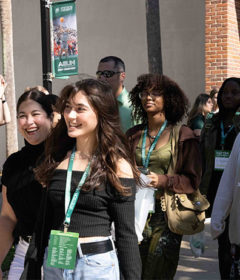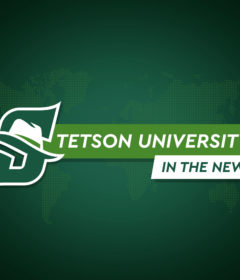Do-or-Die Change
by Beth Paul, Ph.D.
Innovation is not only a hot trend in higher education today; it is an imperative for do-or-die change. Is it just an economic argument, or is there more to the value of innovation in higher education? Why is Stetson University emphasizing innovation in its new strategic map?

Over the past four decades, cautionary messages have turned into sounding alarms about the unsustainable economics of higher education and disruptive innovation as the solution. Headlines urge higher education institutions to define a new, cheaper business model. Technological innovation is seen as the answer for education that is leaner and faster. Student recruitment has become a new competitive sport, complete with scholarship jockeying and amenity envy. Attention-grabbing innovation promises a competitive edge.
Built to Sell
There are elements of reality and truth in the hyperbole of the above-mentioned arguments: The financial accessibility and resiliency of higher education are essential to continuing to realize its societal impact and value. Methods of education need to consider carefully the ways in which students who have grown up as digital natives learn best. And new student recruitment is paramount to overall institutional success — no students, no education.
A strong influence on the urgency for innovation in higher education is the power of innovation as fuel for thriving new business ventures. Innovations are built to sell. Schumpeter’s 20th-century concept of innovation as creative destruction is echoed in Clayton Christensen’s 21st-century call for disruptive innovation — a call he has applied to higher education. Innovation can help businesses capitalize on new human interests, grab the attention of and break into new markets, and increase revenue. The field of higher education has much to gain from such economic expertise and wisdom. Without a healthy business model for higher education, we put at risk the transformational value of advanced learning for society.
But are we just building higher education institutions to sell in the moment, as if we are selling the latest fad or widget, only to be replaced by the next new innovation in a year or two? Or are we building higher education institutions to sustain over the long term as a critical agent of social progress?
Tech vs Tradition
The growing overemphasis on innovation for short-term gain creeping into higher education is why innovation is often a distasteful and uncomfortable concept for the higher education community. Newness or novelty may gain initial attention, but it may not help us attain our mission-directed goals. For example, the urgency of cries for technology as a disruptive innovation in higher education is amplified by enterprising venture capitalists who see significant financial gain in technological revolution of the education market.
As a response, too many in higher education have defensively held fast to tradition, rejecting innovation as frivolous, unnecessary and even dangerous. Yet, institutions like Stetson cannot be complacent and ignore healthy dynamism that is necessary for maintaining a strong position in the market and to fulfilling the university mission.
How does innovation for sustainability, rather than the odds of immediate revenue gain, help us to realize the value of innovation for Stetson’s long-term health? Instead of innovation simply for the sake of newness or novelty, how can innovation be a positive strategy for Stetson now and well into the future?
Innovation for Sustainability
I believe there are four core advantages of innovation for sustainability for Stetson:
First is vitality. Howard Thurman observed, “Don’t ask what the world needs. Ask what makes you come alive, and go do that, because what the world needs is people who have come alive.” A vital learning community is alive with people who are open, asking, thinking, challenging, risking, failing and learning. At its core, innovation is about fresh thinking. It is about being imaginative, creative and clever. It is about seeking out and sitting with differing perspectives and ideas, allowing them to marinate and mingle, opening new questions, ideas and solutions. Such a learning community creates energy and momentum that attracts diverse learners of all ages.
Second, at Stetson our aspiration for our students — for all in the Stetson community — is that we dare to be significant in the world. In whatever our chosen spheres of influence, how can we make the world a better place? Innovation is a process of defining and effecting change: finding or defining a different and hopefully better way of doing something. Necessary for spurring each of us to dare to be significant is a vital learning community that facilitates innovative thinking and builds the habits of heart and mind that fuel innovative action. Stetson’s core commitment to liberal learning is critical to this goal and is amplified by intersection with professional exploration and preparation and holistic student development. Fulfilling this promise will create graduates who are coveted employees, citizens and leaders.
Third, at the core of our vital learning community are teacher-scholars who are vital lifelong learners. Through their chosen profession, teacher-scholars dare to be significant as agents of knowledge discovery and architects of students’ learning and transformation. Innovation has been celebrated since the 15th century Renaissance when scientific thought spurred knowledge discovery. Vital faculty cannot help but ask critical questions about how better to facilitate students’ learning, and to advance knowledge and society. Innovations in curriculum, pedagogy and scholarship, and creative activity — that achieve great learning through success and failure — are the lifeblood of a vital learning community.
Fourth, in focusing on innovation as a leading learning virtue, it goes without saying that such a vital organization will also constantly think carefully about the best way to ensure its destiny well into the future. The definition and adaptation of a sustainable business model becomes clearly connected to long-term mission advancement, rather than short-term financial gain.
The exciting challenge in front of Stetson University is to embrace innovation, not in response to the hyperbole in the press, but in response to these four values of sustainability.
Beth Paul is provost and vice president for Academic Affairs at Stetson University.



